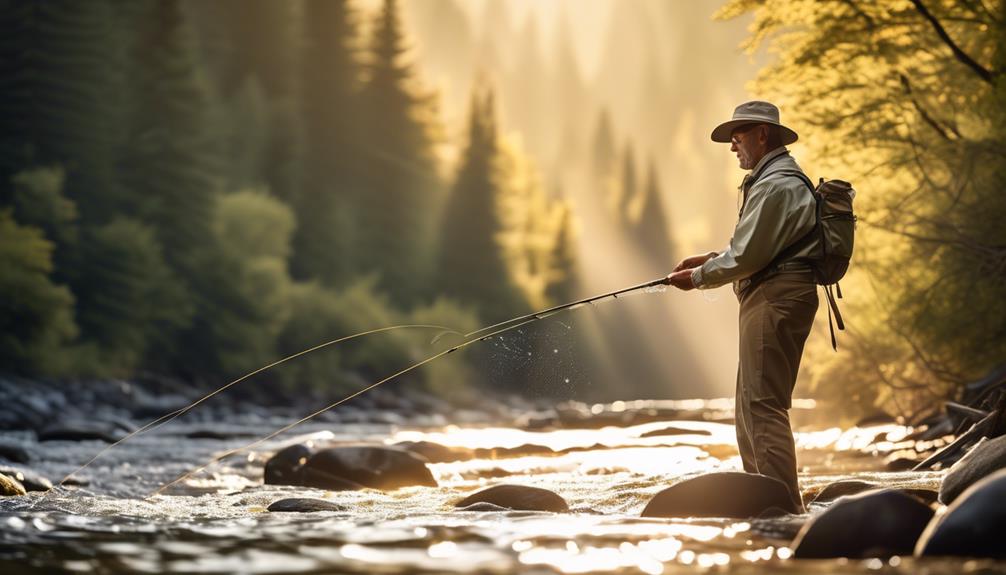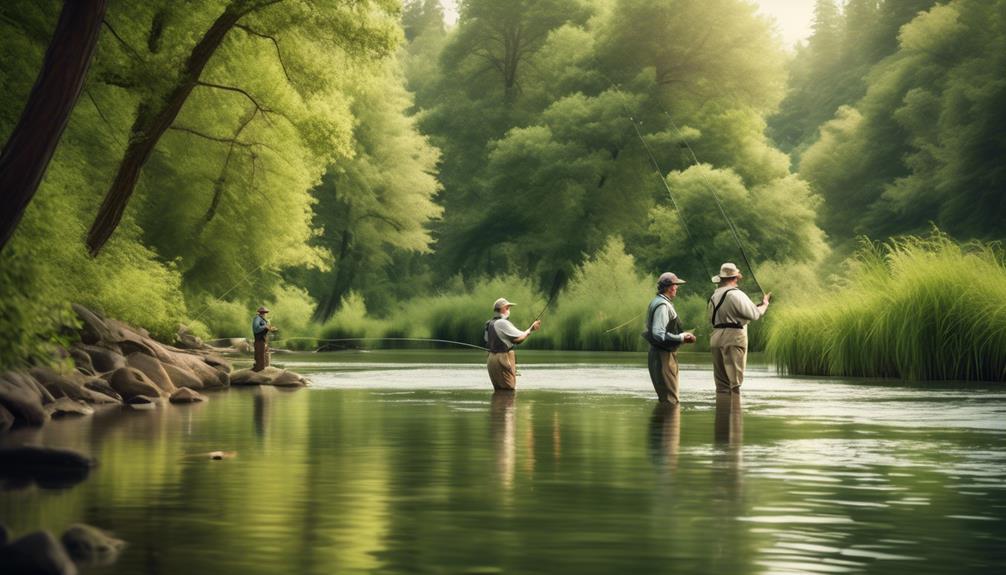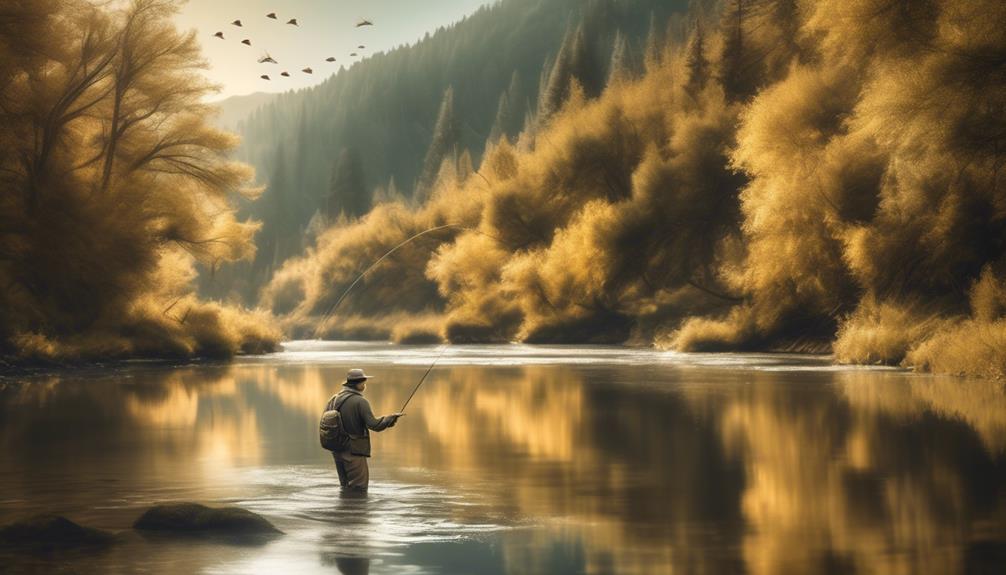Imagine fly fishing for salmon is like a carefully orchestrated dance, where each move must be executed with precision and finesse.
As you stand in the cool, rushing waters, the anticipation of hooking a mighty salmon is palpable.
But how do you ensure success in this challenging endeavor? Let's explore the expert techniques and strategies that will elevate your fly fishing game and help you reel in that prized catch.
Understanding Salmon Behavior
To successfully catch salmon while fly fishing, it's essential to understand their behavior and habitat preferences. Salmon have a remarkable migratory instinct, navigating from the ocean to freshwater rivers and streams to spawn. This migration is a critical aspect of their behavior, influencing their feeding habits and the best times to target them with fly fishing techniques.
During their migration, salmon undergo significant changes in their feeding habits. As they transition from saltwater to freshwater, their focus shifts from feeding to spawning. This shift is particularly evident in their decreased interest in traditional food sources, as they redirect their energy towards reproduction. Understanding this shift is crucial for fly fishers, as it impacts the types of flies and presentation techniques that are most effective for enticing salmon to strike.
Additionally, the timing of salmon migration plays a crucial role in their behavior. Different species of salmon have varying migration patterns, with some returning to freshwater earlier in the year than others. This knowledge is vital for fly fishers, as it allows them to anticipate when salmon will be present in specific areas, increasing the likelihood of a successful catch.
Selecting the Right Fly
When selecting the right fly for salmon fly fishing, consider the local insect hatches and the current water conditions. Fly selection is crucial for successful salmon fishing. To ensure you're using the right fly, pay attention to the following:
- Matching the Hatch: Observing the local insect hatches is essential. Understanding which insects are prevalent in the area will help you select a fly that closely mimics the natural food source of the salmon. Matching the hatch increases the likelihood of a successful catch as the salmon are more likely to be attracted to familiar prey.
- Understanding Fly Patterns: Familiarize yourself with various fly patterns that imitate insects commonly found in salmon habitats. This knowledge will help you choose the most appropriate fly for the conditions you're fishing in. Different patterns are designed to mimic specific insects or baitfish, and selecting the right pattern can significantly improve your chances of enticing a salmon to strike.
- Effective Fly Presentation: Once you've selected the appropriate fly, focus on presenting it effectively. This involves understanding how to cast the fly in a manner that mimics natural movement. Pay attention to the water's current, the depth at which the salmon are feeding, and the speed of your retrieve. Proper presentation can make even the best fly ineffective if not executed correctly.
Mastering the Double-Handed Cast
After selecting the right fly for salmon fly fishing, you can enhance your technique by mastering the double-handed cast, which offers increased power and distance for targeting salmon in a variety of water conditions. Proper rod handling is crucial when mastering the double-handed cast.
Start by gripping the rod with your bottom hand at the bottom of the handle and the top hand above it, keeping your elbows slightly bent. This allows for better control and power during the casting motion.
When performing the double-handed cast, it's essential to maintain a smooth and fluid motion. Begin with the rod tip close to the water and smoothly sweep it back, using your body's rotation to generate power. As you bring the rod forward, allow the top hand to push and the bottom hand to pull, creating a powerful, efficient cast. This technique not only increases casting distance but also reduces fatigue, allowing you to fish for longer periods without tiring.
To maximize the effectiveness of the double-handed cast, focus on timing and rhythm. The transfer of power from your body to the rod should be seamless, with the energy culminating in a smooth acceleration of the line. With practice, you'll be able to achieve greater casting distances with less effort, making it an invaluable skill for targeting salmon in different water conditions.
Navigating Salmon Rivers
Navigating salmon rivers presents unique challenges for fly fishermen due to the ever-changing water conditions and the elusive nature of these prized fish. To successfully navigate these rivers, it's crucial to understand the river geography and the patterns of salmon migration.
Here are some key considerations for navigating salmon rivers:
- River Geography: Understanding the layout of the river is essential for successful navigation. Different sections of the river may have varying depths, currents, and structures, such as riffles, pools, and runs. These features influence where salmon are likely to be found and affect the approach and casting techniques that should be employed.
- Salmon Migration: Salmon migrate through rivers for spawning, and their movements are influenced by factors such as water temperature, flow, and obstacles in the river. Being aware of the typical migration patterns of salmon in a particular river can help fly fishermen anticipate where the fish may be at different times of the year, increasing the chances of a successful catch.
- Adapting to Changing Conditions: As water levels and conditions in rivers can change rapidly, it's important for fly fishermen to stay adaptable. Being able to read the river and adjust strategies accordingly is crucial for effectively navigating salmon rivers and optimizing the chances of a fruitful fly fishing experience.
Perfecting the Swing Technique
Mastering the swing technique is essential for fly fishermen aiming to hook salmon in rivers. This technique involves casting the fly across the current and allowing it to swing downstream, mimicking the natural movement of insects or small fish. To perfect the swing technique, line control and presentation skills are crucial.
Line control is vital when executing the swing technique. It requires managing the line's tension and speed to present the fly in a natural and enticing manner. As the fly swings across the river, you must maintain enough tension to feel the fly's movement while avoiding excessive drag that could disrupt its natural drift. Adjusting the line's length and angle relative to the current is essential to achieve the perfect swing, enticing nearby salmon to strike.
Presentation skills play a significant role in the success of the swing technique. The ability to present the fly convincingly as prey requires a keen understanding of the river's currents and the behavior of salmon. By reading the water and identifying potential holding spots, you can strategically position your fly to attract the attention of salmon. Mastering the art of presenting the fly with precision and finesse will significantly increase your chances of enticing a strike.
Reading Water for Salmon
To identify prime locations for salmon, observe the river's flow patterns and features, such as riffles, pools, and eddies. Identifying salmon habitat is crucial for successful fly fishing. Look for areas where the water is deep enough to provide cover but still has enough current to supply oxygen and carry food. These are the prime spots where salmon are likely to gather.
Additionally, locating feeding zones is essential for a successful fishing expedition. Look for areas where the water is slightly faster, as this indicates a higher concentration of food sources. Keep an eye out for signs of insect activity, such as rising fish or swallows swooping low over the water's surface. These are strong indicators of feeding zones and can lead to a fruitful fishing experience.
When observing the water for salmon, pay attention to the subtle clues that can guide you to the best locations for fishing. By understanding the river's flow patterns and features, you can identify the most promising spots for finding salmon. Keep in mind that identifying salmon habitat and locating feeding zones go hand in hand. By combining these skills, you can significantly increase your chances of a successful fly fishing experience for salmon.
Managing Line and Leader

As you observe the water for salmon, it's essential to manage your line and leader effectively to maximize your chances of a successful fly fishing experience. Line control and leader management are crucial for optimizing your casting accuracy and drift control.
When it comes to line control, it's important to have a good understanding of mending, which involves repositioning your line on the water to achieve a more natural drift. This can be achieved through techniques such as stack mending, reach mending, and aerial mending. By mastering these techniques, you can ensure that your fly drifts naturally in the current, making it more enticing to salmon.
Leader management is also vital in ensuring a successful fly fishing experience. The leader is the clear material that connects the fly line to the fly and plays a significant role in presenting the fly naturally to the fish. Proper leader management involves adjusting the length and weight of the leader to match the conditions and the type of fly being used.
It's important to regularly check and maintain the leader to avoid tangles and knots, which can significantly impact the presentation of the fly.
Landing and Releasing Salmon
When landing a salmon, it's crucial to maintain tension on the line and guide the fish towards a suitable area for safe handling and release. As the salmon nears the shore or the boat, keep the rod tip up and be prepared to adjust the tension as the fish makes its final bursts of energy. Once the salmon is within reach, support its body carefully to avoid harming it.
Here are some essential points to consider for successful salmon landing and release:
- Conservation Ethics: Always prioritize the well-being of the salmon. Minimize the time the fish spends out of the water to reduce stress and increase its chances of survival after release.
- Fish Handling: When handling the salmon, wet your hands to protect its delicate mucus layer. Refrain from squeezing the fish or touching its gills. If you need to remove the hook, do so quickly and gently, using proper tools if necessary.
- Catch and Release Best Practices: Familiarize yourself with the best practices for catch and release. Use barbless hooks to minimize damage and make hook removal easier. Ensure the salmon is fully revived before releasing it by gently supporting it in the water until it swims away under its own power.
Frequently Asked Questions
What Are the Best Techniques for Fishing in Low Light Conditions?
When fishing in low light conditions, you'll want to focus on night fishing techniques and the right equipment. Choose fly selection carefully, and make sure to have the appropriate gear for navigating the water in the dark.
How Can I Effectively Fish for Salmon in Windy Conditions?
When fishing for salmon in windy conditions, you'll face casting challenges. Adapt by using heavier flies or switch to a sinking line to overcome the wind. Pay attention to your casting angle and consider a shorter leader.
What Are Some Tips for Fishing in Heavily Populated Salmon Rivers?
When fishing in heavily populated salmon rivers, handling crowds is key. Be respectful of others' space and casting areas. Practice good river etiquette by giving fellow anglers plenty of room. Patience and courtesy go a long way.
How Can I Adjust My Fly Fishing Techniques for Different Species of Salmon?
When adjusting your fly fishing techniques for different species of salmon, focus on using the right fly patterns and understanding the water currents. By adapting to the specific needs of each species, you can increase your chances of a successful catch.
What Are Some Advanced Strategies for Targeting Larger Salmon?
When targeting larger salmon, focus on deep water and use large lures to attract them. Look for areas with significant depth and use heavy sink-tip lines to get your fly down to where the big fish are.
Conclusion
You've learned the essential techniques for successful fly fishing for salmon. By understanding salmon behavior, selecting the right fly, and mastering the double-handed cast, you're now ready to take on the challenge of fly fishing for salmon with confidence.
Navigating rivers, perfecting the swing technique, and reading water are also important skills to develop. These will help you find the best spots to target salmon and increase your chances of success.
Managing line and leader is crucial for maintaining control over your fly and presenting it effectively to the fish. Practice and refinement will help you improve your skills in this area.
Lastly, landing and releasing salmon properly is essential for the conservation of the species. Take care to handle the fish gently and release them with care to ensure their survival.
Keep practicing and refining your skills, and soon you'll be reeling in the big ones with ease. Good luck and tight lines!



